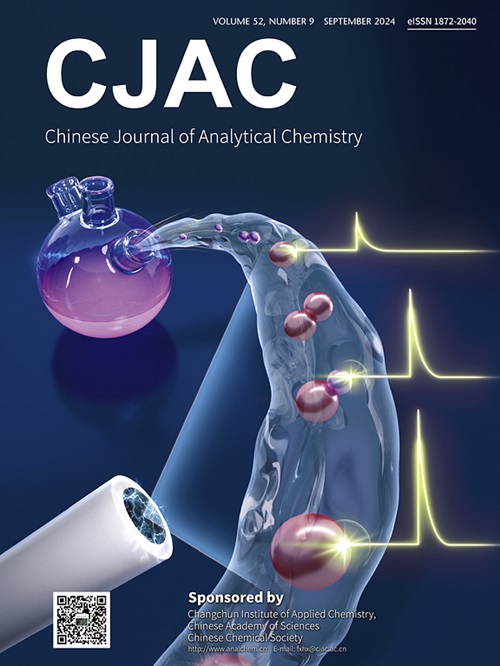A new 3D printing milli-fluidic device with integrated nanojunction for on-site colorimetric analysis of iron in water and soil samples
IF 1.2
4区 化学
Q4 CHEMISTRY, ANALYTICAL
引用次数: 0
Abstract
Fabrication and bonding represent significant challenges in the production of micro- and milli-fluidic devices with integrated functions. Here, to investigate the formation of nanojunction through controlled dielectric breakdown, a thermoplastic material was utilized to create a three-dimensional (3D) printed milli-fluidic device. The device was constructed using a fused deposition modeling 3D printer with acrylonitrile butadiene styrene (ABS). With the application of a voltage between 20 and 25 kV, which was cut off when the current threshold was reached, a controlled dielectric breakdown was used to create a nanojunction in the thin slice of ABS. Both altering the current threshold and the electrolyte ionic strength used for breakdown allowed for different sizes of the nanojunction to be created. The size and transport characteristics of the nanojunctions were observed using electrophoretic transport of two proteins: fluorescamine-labeled bovine serum albumin (f-BSA; 2–4 nm) and R-phycoerythrin (RPE; <10 nm in size), and a small molecule (fluorescein, ∼0.5–1.0 nm) and ions (thiocyanate, ∼0.3 nm). Colorimetric measurement of iron from water and soil slurry samples was utilized to examine the suitability of the 3D-printed device for on-site analysis. Samples were freshly introduced to the 3D-printed milli-fluidic device after Fe3+ was reduced to Fe2+ using hydroxylammonium chloride. The nanojunction captured particle matter, allowing for particulate-free smartphone camera detection for imaging the orange-brown complex produced using 1,10-phenanthroline. The calibration curve covered 1 to 100 μg/mL of Fe2+ using the 3D printed device, which showed good agreement (97.5 %) with ICP-MS.

一种集成纳米结的新型3D打印微流体装置,用于水和土壤样品中的铁的现场比色分析
在集成功能的微流体和毫流体器件的生产中,制造和粘接是一个重大挑战。在这里,为了研究通过控制介质击穿形成纳米结,利用热塑性材料创建了一个三维(3D)打印的微流体装置。该装置是使用丙烯腈丁二烯苯乙烯(ABS)熔融沉积建模3D打印机构建的。施加20 - 25kv的电压,当电流达到阈值时切断,在ABS薄片上使用受控的介质击穿来创建纳米结。改变电流阈值和用于击穿的电解质离子强度允许创建不同尺寸的纳米结。通过两种蛋白质的电泳运输观察纳米结的大小和运输特性:荧光胺标记的牛血清白蛋白(f-BSA);2-4 nm)和r -植红蛋白(RPE;<; 10nm大小),以及小分子(荧光素,~ 0.5-1.0 nm)和离子(硫氰酸盐,~ 0.3 nm)。利用比色法对水和土壤泥浆样品中的铁进行测量,以检查3d打印设备是否适合现场分析。使用氯化羟铵将Fe3+还原为Fe2+后,将样品新鲜导入3d打印微流体装置。纳米结捕获颗粒物质,允许无颗粒的智能手机相机检测成像由1,10-菲罗啉产生的橙棕色复合物。在Fe2+浓度为1 ~ 100 μg/mL范围内,3D打印装置的校准曲线与ICP-MS的一致性较好(97.5%)。
本文章由计算机程序翻译,如有差异,请以英文原文为准。
求助全文
约1分钟内获得全文
求助全文
来源期刊
CiteScore
3.60
自引率
25.00%
发文量
17223
审稿时长
35 days
期刊介绍:
Chinese Journal of Analytical Chemistry(CJAC) is an academic journal of analytical chemistry established in 1972 and sponsored by the Chinese Chemical Society and Changchun Institute of Applied Chemistry, Chinese Academy of Sciences. Its objectives are to report the original scientific research achievements and review the recent development of analytical chemistry in all areas. The journal sets up 5 columns including Research Papers, Research Notes, Experimental Technique and Instrument, Review and Progress and Summary Accounts. The journal published monthly in Chinese language. A detailed abstract, keywords and the titles of figures and tables are provided in English, except column of Summary Accounts. Prof. Wang Erkang, an outstanding analytical chemist, academician of Chinese Academy of Sciences & Third World Academy of Sciences, holds the post of the Editor-in-chief.

 求助内容:
求助内容: 应助结果提醒方式:
应助结果提醒方式:


